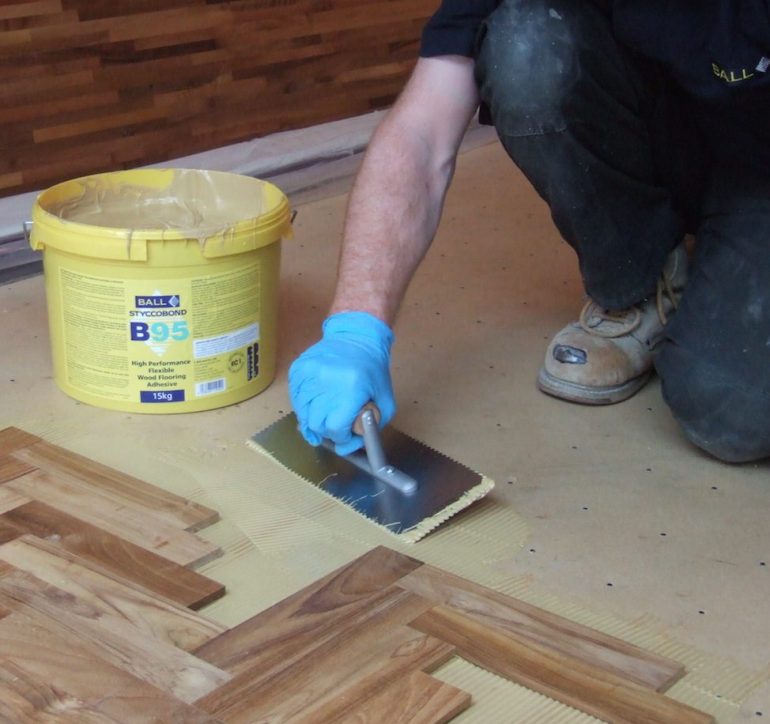Q. How long after applying a waterproof surface membrane should Stopgap 1200 Pro be applied?
A. You can apply Stopgap 1200 Pro over a waterproof surface membrane, such as F. Ball’s Stopgap F77, directly when the waterproof surface membrane has cured. If you apply Stopgap 1200 Pro within 24 hours of Stopgap F77 curing, there’s no need apply a primer beforehand. F78 is a membrane and primer in one, therefore all F. Ball smoothing compounds can be applied direct within 12 hrs of the membrane drying.
Q. Carpet tiles adhered with carpet tile tackifier are lifting. The concrete below is weak and friable. What’s the best course of action?
A. In many cases, a weak or friable surface can be reinforced using a surface reinforcement system (SRS), such as F. Ball’s Stopgap SRS, a two-component epoxy resin reinforcement material designed to quickly stabilise and reinforce weak sand/cement or calcium sulphate screeds. You’ll first need to remove the carpet tiles and adhesive and check the likelihood of success of a surface reinforcement system according to manufacturer’s instructions. This is typically done using In Situ Crushing Resistance (ISCR) tests, involving weights being dropped from specified heights to test the soundness of the screed. After mixing together Stopgap SRS’s two components, pour over the weak subfloor and spread out with a rubber squeegee, working into the surface until no more liquid is absorbed. The product penetrates the weak/friable surface, filling voids and static cracks and binding loose particles to strengthen the screed. Stopgap SRS works overnight to provide a suitable base for the subsequent installation of subfloor preparation products.
Q. Can forklift trucks be used over Stopgap 300 HD?
A. Stopgap 300 HD is suitable for application in areas that will be subject to light to heavy use, including where heavy machinery will be operated. Suitable floorcoverings will need to be installed over Stopgap 300 HD. If the underlayment is intended to be left as a stand alone wearcoat, you should use Stopgap 800 Wearcoat instead. Stopgap 800 is a self-levelling, commercial and industrial grade floor compound for light to heavy duty applications where floorcoverings will not be installed, such as workshops and warehouses.
Q. Recently-installed wood blocks installed are lifting in a building that is over 100 years old.
A. This is likely caused by subfloor moisture, as a building that old will not have a structural damp proof course. Where subfloor moisture levels are above 65% relative humidity (RH) and wood floorcoverings are installed, there is the potential for excess subfloor moisture to cause floor failure. You will need to lift the blocks, remove adhesive residues and make sure the subfloor is suitably clean before installing a waterproof surface membrane. F. Ball’s Stopgap F77 waterproof surface membrane is ideal as it will impede the passage of excess subfloor moisture where RH values are up to 98%. First. Apply Stopgap F77 in one coat, ensuring complete coverage, and leave to dry. You can then use Styccobond B95 wood flooring adhesive to adhere the wood blocks to the waterproof surface membrane. If this is done within 24 hours of the waterproof surface membrane drying, there will be no need to apply a smoothing underlayment first.
Q. Can I apply Stopgap F77 to a calcium sulphate screed with underfloor heating?
A. No. Waterproof surface membranes are not suitable for application over calcium sulphate screeds. Instead, let the screed dry out, until the relative humidity level of the subfloor is below 75% (65% if wood floorcoverings are to be installed). This can be speeded up by ensuring areas are well-ventilated, by opening windows and doors or using a dehumidifier, as well as by turning on the underfloor heating system to encourage the evaporation of moisture.
Q. I’m installing new floorcoverings in a converted garage with ceramic tiles. Can I go straight to applying a levelling compound?
A. If the ceramic tiles are well bonded, clean and installed over a permanently dry base, there’s no need to remove them. You will need to apply a primer beforehand, to promote adhesion between the levelling compound and the subfloor. Stopgap P141 is F. Ball’s primer for use on non-absorbent surfaces, such as ceramic tiles. It is specially formulated to create a textured finish and enhance bond performance.
Our technical team are on standby to answer questions about your projects and F. Ball products from 7.30am – 5.00pm, Monday to Friday.
Please note: site conditions vary. Don’t rely on these specific responses for your own project. If you are unsure about any technical issue relating to specific flooring installations, contact the F. Ball Technical Service team on 01538 361633 or consult the product data sheets available from F. Ball’s website.


